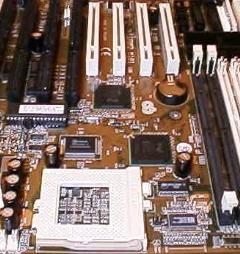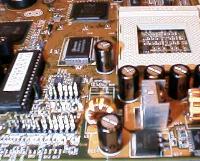| Socket Style: | Socket 7 |
| Chipset: | i82430TX |
| Cache: | 512KB |
| Form Factor: | AT (w/ AT & ATX PS Connectors) |
| BUS Speeds: | 50 / 55 / 60 / 66 / 68 / 75 / 83 MHz |
| Clock Multipliers: | 1.5x / 2.0x / 2.5x / 3.0x / 3.5x |
| Voltages Supported: | 2.8 / 2.9 / 3.2 / 3.38 / 3.5 |
| RAM Slots: | 4 72pin SIMM
Slots (EDO/FPM) 2 168pin DIMM Slots (EDO/SDRAM) |
| PCI/ISA Slots: | 4 PCI Slots 4 ISA Slots |
| BIOS: | AWARD PnP BIOS w/ SeePUTM Jumperless CPU Setup |
| PCI EIDE Controller: | Super I/O 2 EIDE Channels 1 FDD Channel 2 Serial /1 EPP |
 |
Start off with the layout of the motherboard, although the AT form factor can be quite cramped at times studies have shown that about 60% of the market is interested in an AT based motherboard. One of the major reasons for this is the amazing price and availability of large server size T cases. Chaintech managed to outfit the 5TDM2 with 4 PCI and 4 ISA slots, something often overlooked by manufacturers in recent times. Expanding on this Chaintech decided to include a spacious 4 SIMM and 2 DIMM slots which encourage expandability as well as offer the user the flexibility of using cheaper EDO or even FPM SIMMs while providing you with the possibility of upgrading to SDRAM with which you are able to use flawlessly even in pairs on the 5TDM2. |
Worried about jumpers? Not with the 5TDM2, like most newer Chaintech motherboards (with the exception of the 5Sxx series) this TX wonder uses the patented SeePUTM (you've gotta love that name) technology which is a Jumperless CPU Configuration Utility much like ABIT's SoftMenuTM setup. From the Chipset Features setup in the AWARD PnP BIOS utility the user is allowed to select from a list of pre-defined CPU settings in order to expedite the installation/configuration process. However the user also has the option of enabling the User's Favorite setting in the SeePUTM setup which allows you to manually select the bus speed, clock multiplier, and core voltage settings for your configuration. The Bus speeds available range from 50 - 83.3MHz including the turbo frequency of the 66MHz bus speed (68MHz) and the clock multipliers the user has to choose from cover the standard 1.5x - 3.5x.
As if the jumperless setup of the 5TDM2 wasn't enough the Chaintech manual, like many aspects of their motherboards, is comparable to the "Engineering 101 Manual" from ABIT. Why is this? Well word has it that the person writing the Chaintech manuals used to be an ABIT employee =) Regardless, the quality of the Chaintech manual is excellent, its detailed diagrams and in-depth summary of the features of the mainboard as well as its excellent coverage of the AWARD BIOS Setup utility make it second to none (ABIT excluded :-)...) To make your experience with Chaintech a more pleasant one bundled with the 5TDM2 you'll find a Intel TX Busmastering Driver Disk, a feature most manufacturers have decided to include with their motherboards.
| The quality put into the 5TDM2 itself is superb, from the large capacitors found near the Socket-7 IC to the locking mechanism used with the DIMM slots (now that may not be an important feature however it actually makes installing your DIMMs much easier) the 5TDM2 was designed with excellence in mind. Although it may have not acquired that level of excellence Chaintech wished for it to, the 5TDM2 comes pretty close, especially with its "intelligent mainboard" functions. This is something we've all heard of, "intelligent mainboards", the 5TDM2 has also made its way onto this bandwagon, this time with a fully functional Active Process Temperature Control (APTC) unit as well as an optional System Monitoring & Alert Technology (SMART) operation utility. Be sure, when ordering the 5TDM2, to specifically ask that the APTC unit is installed and operational, otherwise you get whatever the vendor decides to give you. This was a huge controversy with the ABIT TX5N which supposedly featured similar options however the initial revisions of the motherboard never provided users with anything even remotely resembling those promised. Nevertheless, the 5TDM2 DOES provide the user with the option of having certain "intelligent mainboard" controls at their fingertips, which can prove to be very useful if you are running in a do or die environment that simply will not tolerate a failure. |  |
The stability of the 5TDM2 is excellent at almost every single achievable setting with exception to the really "out-there" overclocked settings (i.e. 290MHz - Pentium MMX & 250MHz - K6). Performance wise the 5TDM2 is superior to that of its predecessor the 5TTM and feature wise it can't be beat by some of the most competitive of rivals. The problems with the 5TDM2? You didn't expect this to be the perfect mainboard did you now?
The 5TDM2 suffers from a few problems that decrease its overall quality as an "overclocker's motherboard." First of all the SeePUTM Jumperless CPU Configuration utility only allows you to select from a limited amount of core voltage settings for your CPU, limiting the amount of overclocking possible with the motherboard. For example, with the Pentium MMX you are limited to at MOST a 2.9v core setting, which unfortunately doesn't cut it at 290.5MHz (83.3 x 3.5) although it is perfectly ok at 262.5MHz. Secondly, the long term reliability of this motherboard is pretty much unknown due to the fact that in spite of its 12 oversized capacitors onboard the 5TDM2 lacks the quality Sanyo capacitors almost necessary for operation out of spec, in other words "overclocking like a madman." Depending on whether or not that description matches your personality determines how well the 5TDM2 will suit your needs.










1 Comments
View All Comments
Flemints - Friday, March 29, 2019 - link
nice post